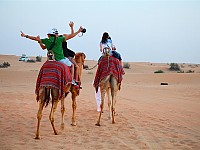
The falling oil prices force Saudi Arabia to change its direction. As a new source of income, the previously not very tourism-friendly country wants to tap into travel business. Saudi Arabia tourism is to expand, but still not for everyone.
The strict Muslim country plans to invite tens of thousands of tourists with exclusive visa and expand its tourism industry. This was announced by Prince Sultan, the oldest living son of king Salman and the chief of the Saudi commission for tourism and national heritage.
Saudi Arabia tourism will open up, but not for everybody. According to the prince: “The country was already open for businessmen, people who work in Saudi Arabia and people visiting for special purposes. Now it will be open for tourism on a selective basis.”
As of now, Saudi-Arabia is not issuing any tourist visa. Between 2006 and 2010, it ran a pilot program which invited up to 25,000 visitors into the country per year. It’s not yet clear when the visa will be available again. The kingdom wants to display its rich heritage, including cities from the time before Islam, the Prince continued. Locals are also encouraged to spend a little of their travel money domestically.
Saudi Arabia Is Not a Cash Dispenser
Prince Sultan envisions a kingdom, which mainly attracts visitors from the Gulf region, who are ready for bigger spending. As a study by the travel technology company Amadeus from 2014 revealed, tourists from Saudi Arabia, Kuwait, Qatar, the United Emirates, Bahrain and Oman alone will spend 216 billion dollars (roughly 191 billion Euros) until 2030. This means that a tourist from these countries spends USD 9900 per holiday. These well-off travelers however mostly holiday outside of the Persian Gulf.
Saudi Arabia tourism professionals now promote domestic travel opportunities in an effort to attract part of this travel money, but also to facilitate a stronger national identity of the kingdom’s youth.
“So many people only view their country as some kind of a cash dispenser, which is very, very sad,” the Prince laments.
According to him, the travel sector could be one of the most promising industries to create real, meaningful, sustainable jobs, which Saudis will like doing. Data of the tourism commission shows that roughly 245,000 Saudi Arabians work in tourism. Their goal is to raise this number to 352,000 until 2020. This goes hand in hand with the plan to raise investments in the tourist sector to 46 billion dollars, which is an additional 8 billion dollars.
Even though 11 million Muslims a year pilgrimage to the holy cities of Mecca and Medina, the Saudi Arabia tourism infrastructure outside of these cities is still in very early stages. “Missed opportunities are a great danger for every economy or country,” said the Prince.
Kingdom Ready for Changes
The Saudi cabinet approved the plan “Vision 2030”, which is supposed to prepare the kingdom for an era of lower oil prices. The receding prices undermine the country’s ability to finance subventions, wages and infrastructure projects. Currently, 70 percent of all 30 million Saudi Arabians work for the government.
The demographic change endangers this structure: More than half of all inhabitants are less than 25 years old. Soon, millions of people will look for work and inexpensive housing.
It is intended to raise the percentage of women in jobs from 22 percent to 30, continuing the upward trend of the last five years. Furthermore, Arabs and Muslims from other countries are supposed to receive better job opportunities due to more generous residence permits.
All of these projects lie on the shoulders of the state fund PIF. Its wealth is supposed to climb from 160 billion to 2000 billion dollars as part of an all-compassing restructuring. PIF is planned to be the center and focus of all international investments.










